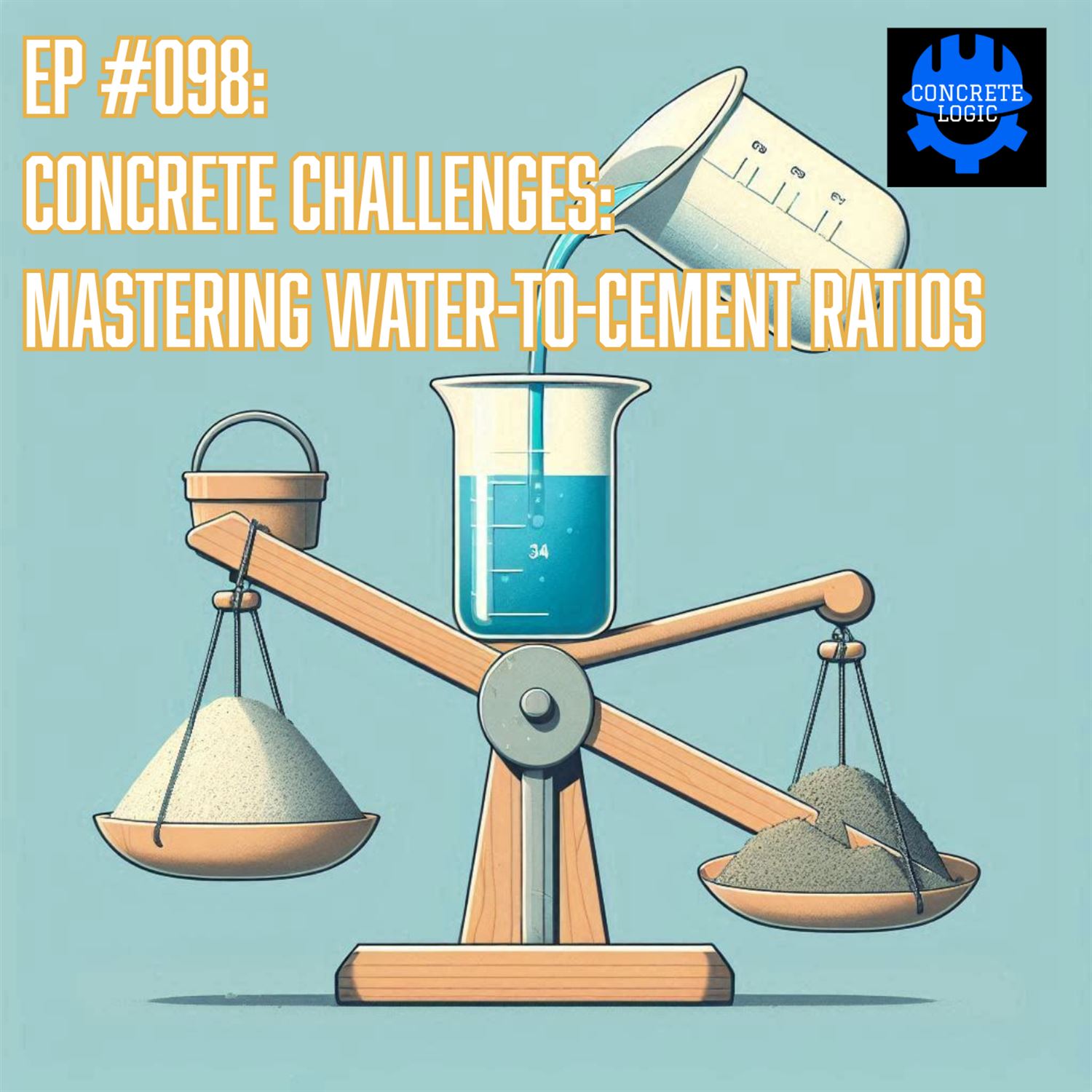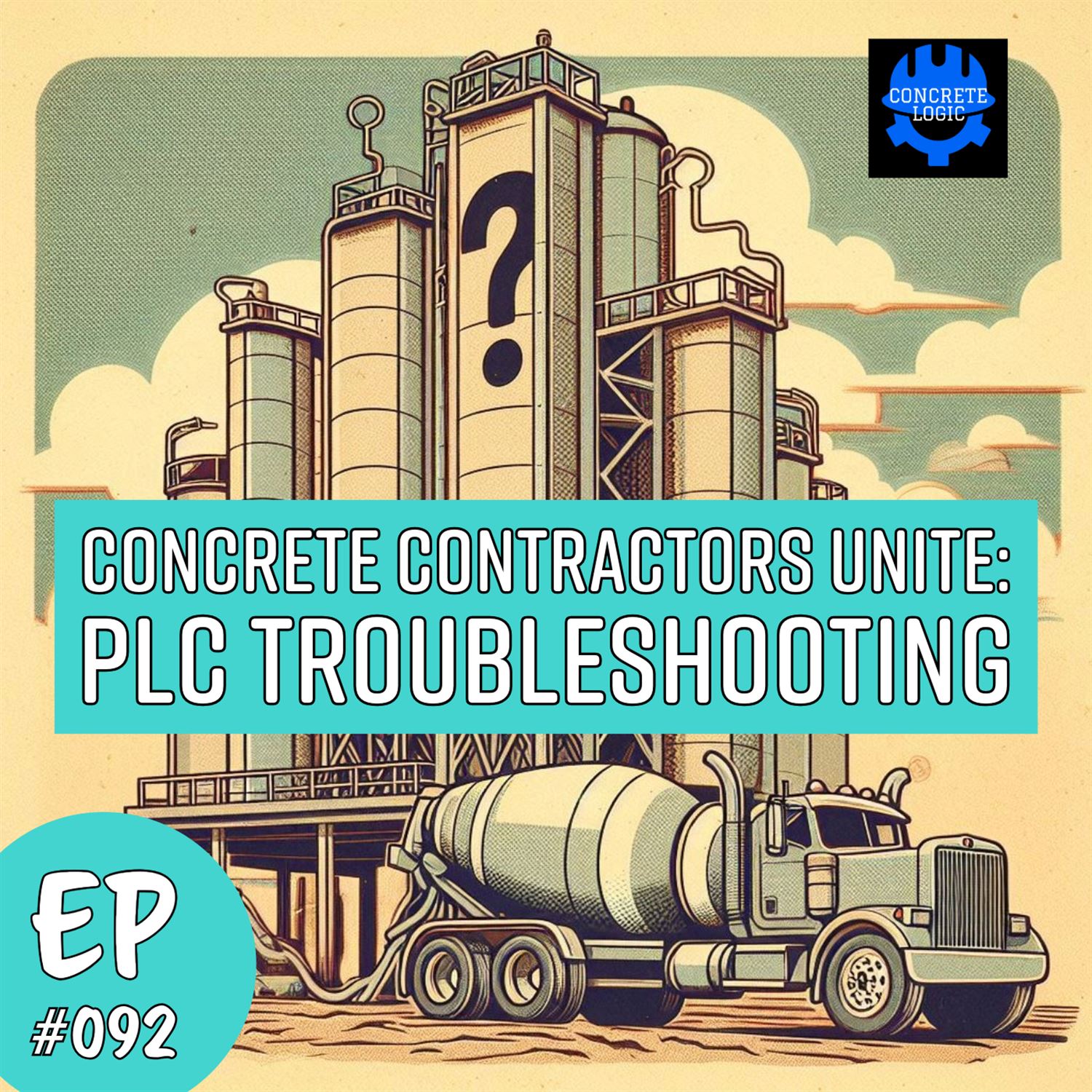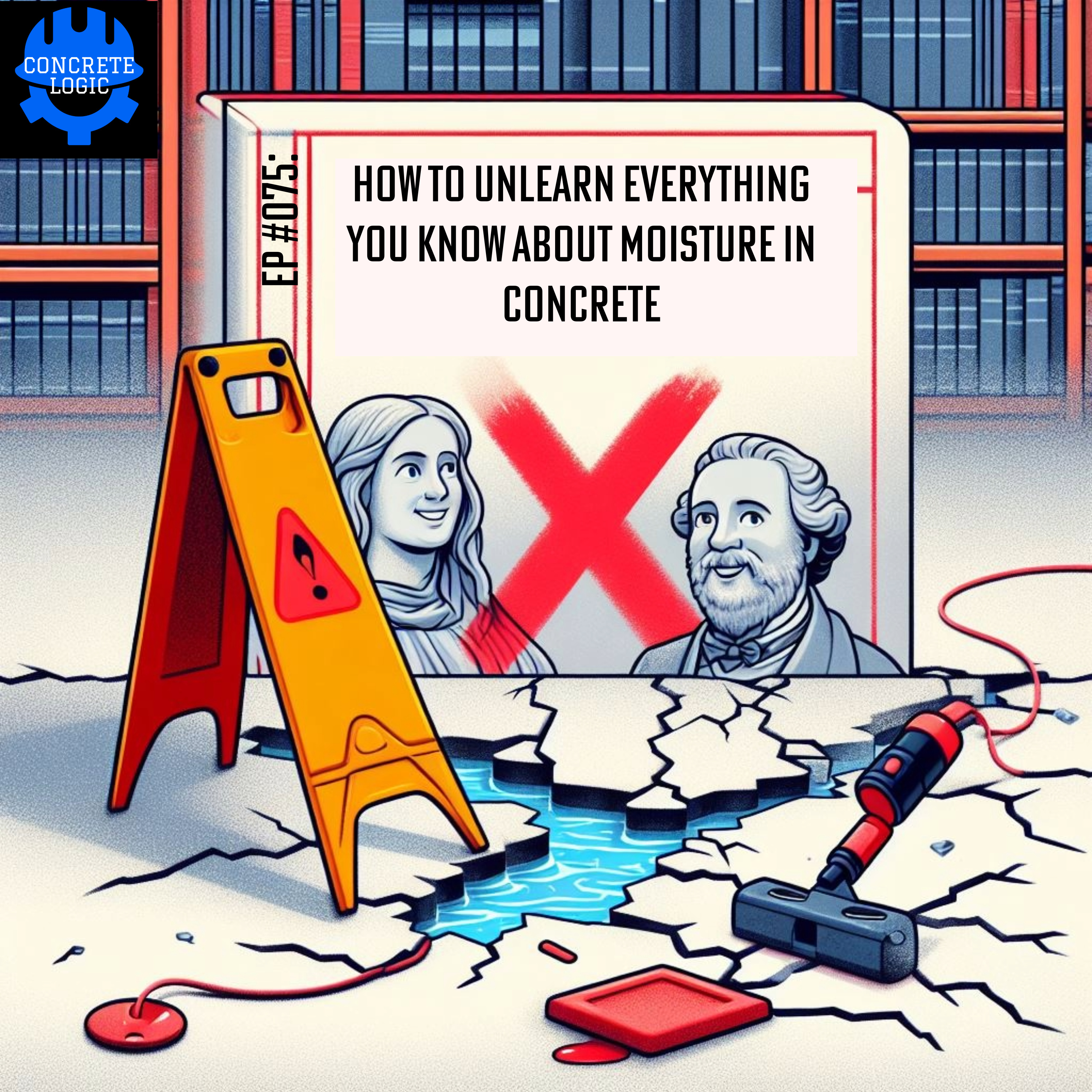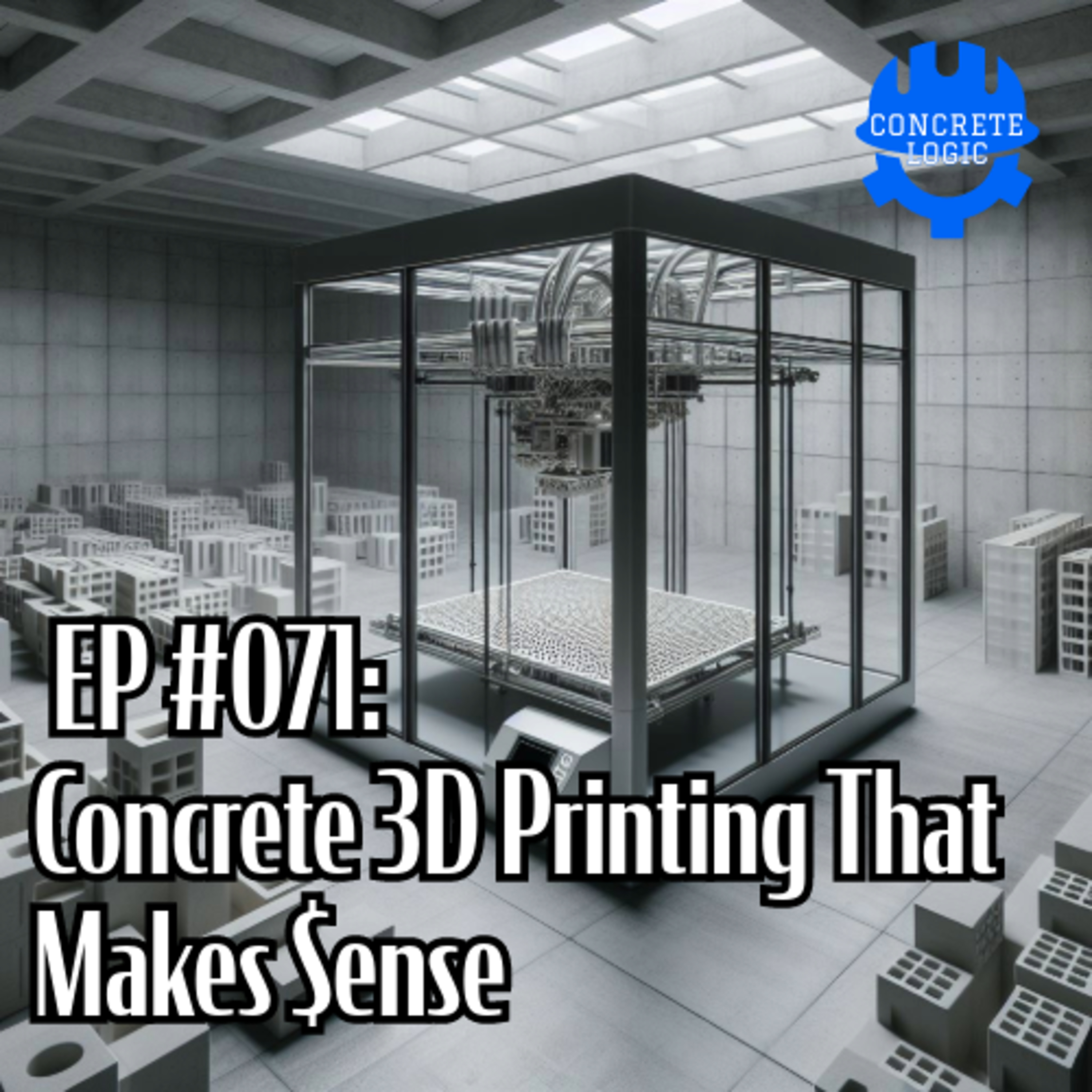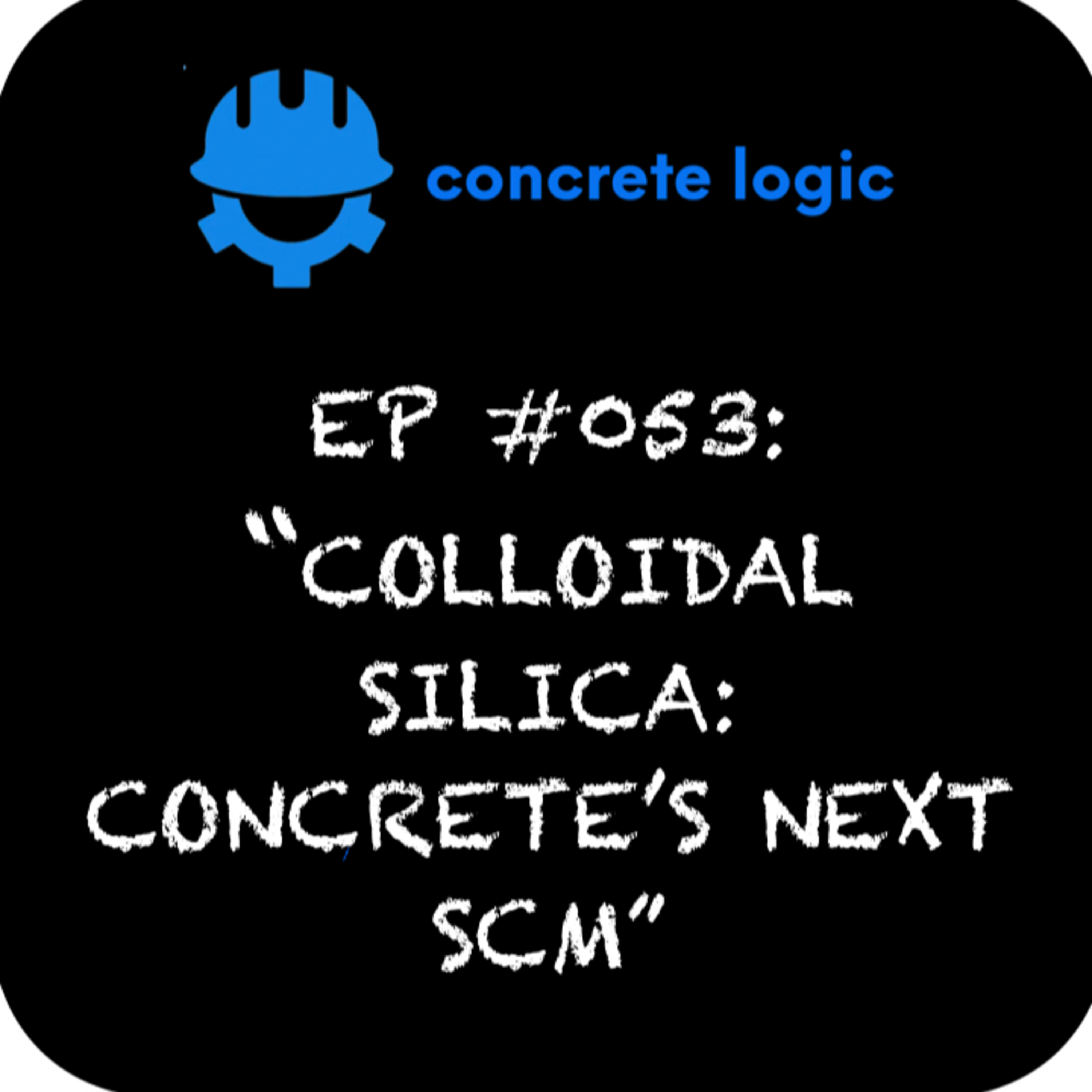
EP #088: Concrete Pumping 101

In this episode of the Concrete Logic Podcast, Seth interviews Gary Brown, a business development professional with 47 years of experience in the concrete pumping industry.
They discuss the introduction to concrete pumping, its various types, operation, impact on concrete mix design, and safety considerations. Gary also shares insights on the American Concrete Pumping Association's safety initiatives and the lucrative career opportunities in concrete pumping.
Takeaways
- Concrete pumping is a versatile and efficient method of moving concrete, reducing labor and expediting the placement of concrete in various construction projects.
- The American Concrete Pumping Association (ACPA) has introduced safety initiatives to promote safer practices and reduce accidents in the concrete pumping industry.
- Concrete pumping offers lucrative career opportunities, with operators earning high earnings with experience and additional hours worked.
- The impact of concrete pumping on concrete mix design has led to the development of pump-friendly mixes, with a focus on fluidity and safety considerations.
- The history and evolution of concrete pumping have significantly influenced construction practices, especially in high-rise and infrastructure projects.
Chapters
00:00 Introduction to Concrete Pumping: Types and Operation
08:20 Impact of Concrete Pumping on Mix Design and Safety
***
Did you learn something from this episode? If so, please consider donating to the show to help us continue to provide high-quality content for the concrete industry.
Donate here: https://www.concretelogicpodcast.com/support/
***
Episode References
Guest: Gary Brown | R.L. McCoy | garybrown@rlmccoy.net
Guest Website: https://www.rlmccoy.net/, https://www.wearesafertogether.org/
Producer: Jodi Tandett
Donate & Become a Producer: https://www.concretelogicpodcast.com/support/
Music: Mike Dunton | https://www.mikeduntonmusic.com | mikeduntonmusic@gmail.com | Instagram @Mike_Dunton
Host: Seth Tandett, seth@concretelogicpodcast.com
Host LinkedIn: https://www.linkedin.com/in/seth-tandett/
Website: https://www.concretelogicpodcast.com/ LinkedIn: https://www.linkedin.com/company/concrete-logic-podcast
Seth (00:04.049)
Welcome to another episode of the Concrete Logic Podcast. And today I have Gary Brown with me. Gary Brown's from RL McCoy. Gary is a business development over there, but he's been in the pumping, concrete pumping industry for 47 years. So he's got a, he's got a lot of knowledge that he's going to share. Not all of it today though. We're not going to do all of the sharing today. So I hope, I hope Gary enjoys this. I know we're going to,
We're going to talk about concrete pumping today and if he likes to do this I'm gonna I'm definitely invite him back. So we're just gonna do an introduction to concrete pumping and and then yeah, so But before we get started Gary Same thing. I tell y 'all every episode how this podcast works. So we have no advertisers and the
reason we do that is so we can bring on whoever we want. and we don't have any commercials or anything like that. So the, the, the way we do that is I ask you guys to do three, three things for me. And, one of the three things is if you enjoy this podcast, please share it with a colleague or coworker in the industry. the second thing you can do is if you go to concrete logic podcast .com, you can, hit the contact.
There's a contact link on there and you can shoot me a message and give me an idea on a topic or guest. And then the other way you can get ahold of me is there's a little microphone in the bottom right hand corner of the same ConcreteLogicPodcast .com homepage. You can actually leave me a voicemail. So if you prefer to leave me a voicemail, I'm a guy that like, I rather talk than type. I talk easier than I type. So that's why that's there.
and then the last, way is, is, there's a, on the same homepage, there's a donate button. You can click on the donate button. And if you feel like we gave you some kind of value today and you want to return that value in a monetary, way, you can do that by clicking that and you can give any amount. It doesn't tell you, it doesn't force you amount. There's no paywalls or anything like that. I don't have premium,
Seth (02:27.665)
Content or any of that other nonsense that's out there. You just click on there and you send whatever amount you want today We got one donation It's my it's my wife Gary Gary. She's always sitting she's she's sending me money for my podcast She she's sending $12 and 47 cents Appreciate that and Yeah, so you that's how it works guys
and she'll be listed as producer for this episode. This should be episode, I believe 88. So there's, you know, after this one's released, there's 88 episodes for you all to check out. So, yeah, a lot of content for you. Gary, let's get started here. Gary, like I mentioned, Gary's been in the concrete pumping industry for a long time. And I'm gonna go ahead and start.
We have not out of the 87 episodes. I don't think we've had, I know we haven't had a podcast episode dedicated to concrete pumping. So this is going to be a good one. Gary, just to get us started, could you just tell us what concrete pumping is for, you know, not everybody knows what that is.
Gary Brown (03:40.22)
Sure. Concrete pumping is a vehicle of moving the concrete from the ready -mix truck through the machine, through either a boom of some sort, pipeline and hose to a point where the ready -mix truck can't just drive up to and either direct shoot into the forms or slab work. So it's a vehicle for moving concrete in places that was never designed to actually be with.
It eliminates crane and bucket Georgia buggies for those wheelbarrows for some people and it expedites the ability to move concrete at a higher speed and velocity.
Seth (04:19.437)
Yeah, and when I always get excited when I see the see them driving down the road and I point them out to me if my kids are with me I point them out I tell them that's a concrete pump But not I don't think people pay attention like when a truck drives by like a concrete pump drives drives by that They know what that thing is To me. It looks like it. It's an oversized like fire truck with a folded up steel hose on the top of it in a scissor kind of scissored down
Gary Brown (04:49.436)
The boom truck is configured to where a lot of people mistake it. Some people mistake it for a well drilling or some sort of a crane. But the concrete pump over the last 60 plus years has been designed to where now it can move upwards of 200 plus yards of concrete per hour, which is almost a million pounds of material every hour for hours on end. It's one of the most versatile machines. It's changed all the ways of construction over the years from...
just house slabs all the way up to high rises. So it's been a very intricate tool that has made placing and moving concrete much more efficient, less labor intensive than previous methods.
Seth (05:32.113)
Yeah, and and when when the truck Well, let's talk about the different types of concrete pumps and then we can talk about how they operate because that's pretty cool, too
Gary Brown (05:43.644)
There's multiple different kinds of equipment. We'll start out with grout pumps, which are generally used for slushing block wall. The masonry contractors, if they have to slush their walls, or if you work in the southern states where they slush grade beams for hurricane protection for houses in like Florida, Louisiana, that area. Then they move up to small trailer pumps, which a lot of light commercial contractors employ in their...
daily business where they pull them behind a pickup truck to place slabs or sidewalks out of the reach of a ready -mixed truck. Then we go to the bigger trailer pumps that are used in high -rise concrete pumping generally where they have the pressures capacities to pump 100 stories up with no problem. And then there's always the boom trucks, which is probably what you see on most job sites day in and day out.
There's approximately 11 ,000 to 12 ,000 boom pumps throughout the United States. It's not a very big number, but they're all working every day. And those concrete pumps generally have the capacity to start at 100 to 140 yards an hour, all the way up to 200 plus yards an hour, depending on the type of pump that's in the actual boom.
Seth (07:00.625)
Right. And what the boom, the boom pumps probably the most prevalent, right?
Gary Brown (07:06.716)
the most popular, the most request on almost any job site is a boom pump. Most general contractors don't like to handle pipe and hose unless they absolutely have to because the labor intensity, the vigorous activity is the most likely chance of possibly hurting somebody because of the weights. So whenever they can use a boom truck, there's boom trucks that start out at.
20 meters, which is like 55 feet going all the way up now to 75 meters here in the US, which is about 220 plus feet. So there's a lot of different sizes out there that can be employed. When the boom trucks run out of reach, that's where we go to detachable or a placing boom application that goes into a superstructure for high rise construction. That's where your big trailer pump sits on the ground and pumps through pipeline up through the building.
and different sized boom trucks, or placing booms set on top of the pedestal to pour concrete, vertical work, and expedite the pour sequences by being able to place concrete, larger volumes of concrete in a very short time.
Seth (08:20.625)
Yeah, I saw someone posted on LinkedIn. I think it was a 70, I think it was 72 or 75 meter. And it just, that just seems amazing to me. Do you think that we're getting to the limit on the size of pumps? Cause of, I was kind of researching, I was asking the guy that posted, the, the, the 72, again, I think it was 72 or 75 meter, but,
I was asking him the weights of that truck when it's in transportation mode, it's folded up and going, because our roads and bridges are only rated for a certain amount. So I was wondering if you get to a point where you can't, you can't, you're so big, you can't drive it anywhere.
Gary Brown (09:06.076)
Right now your 70 plus meter concrete pumps are going to weigh in excess of 140 to 160 ,000 pounds. In the southern states, you're able to run 20 ,000 per axle in most states without a daily permit, which means you're going to get somewhere in the 140 to 160 ,000, which is in that 72 to 75 meter range. Here in Indiana, we can only run 125 ,000, so we can't run.
a pump that big. So it depends your size and location. I know they do have an 86 meter that Sandy makes that is in Asian countries. Another thing that they're exploring right now to make bigger booms, they've got some of them with carbon fiber in the booms to lighten the boom weights and help with the tipping loads, which is another issue when you get into those 75 meter boom weights.
the setup because of the outrigger spread sometimes limits the ability to set up on certain job sites because you need a 50 by 50 square for those big pumps like that. Not every job site has a half a football field for it to set up. And so we're kind of reaching that limits. There's talk on how to redesign to get to longer limits. I don't know that they'll get there anytime soon mainly because of road restrictions. Like you said, that a lot of states that...
They only allow certain weights and Indiana is one of those states that tops out at 125 without what they call super load permits, which when you see these big axles, these trucks with multi axles moving equipment that have all the axles underneath it, that gets into that super load and escort and flagging and that would be almost insurmountable for our industry because our industry doesn't always think far enough ahead to move a piece of equipment like that.
job A to job B. So we're at almost at our limit for now.
Seth (11:04.433)
All right. And we kind of hit on some of the benefits. You mentioned some of what's the benefits of concrete pumping. If you were to try, if you were trying, you're in business development and so you're out there and you trying to get everybody to use your pumping services, right? So what it, for some, I know a lot of guys just, you know, we like to see the pumps out there and they make the job a little bit easier, but what, what other benefits are out there?
Gary Brown (11:22.908)
That's true.
Gary Brown (11:35.132)
Besides the speed at which a concrete pump can move concrete, it can also bring it to a point of placement with very little effort. So you can put it directly into the form with different types of hoses and configurations off the end of the boom. It reduces labor. Every contractor is interested in how to reduce labor. So that helps in a safety aspect. When you're using a boom truck compared to a pipe and hose, you don't...
you're not picking these heavy pipes and hoses loaded full of concrete. So you reduce the opportunity for injuries. And we're always, all of us are concerned about a workman comp incident or a severe injury trying to pick something up and injure a worker. So the concrete pump has just been an all around useful tool in expediting the job. And I think that's the biggest selling point because it can move concrete extremely fast from, you know,
10 yards an hour to 100 yards an hour at a very easy pace. And if there's a place to put the concrete, it can exceed those amounts of concrete per hour. I mean, it can unload 10 yards, which is 45 ,000 pounds of concrete in two minutes and 35 seconds. So that gives you an idea of how fast you can rotate a concrete truck. The ReadyMix suppliers like it.
If you're a housing contractor, you can do multiple pours throughout the course of the day with a concrete pump where you may not be able to when you're direct shooting, which used to be the way that they did it and it automatically alleviates a lot of possible hazards of a truck getting too close to the forms or the dirt walls that go around basements and such. So between safety and production, I think those are the two prime.
reasons why concrete pump is the tool of choice.
Seth (13:34.449)
And the diameter of the pipe, what is the most used diameter?
Gary Brown (13:43.452)
If we're grouting, we're going to be in the two inch range with a two inch hose. If we're doing the pea gravel mix, you might go up to two and a half. You can move some natural gravels through three inch. Your limestone mixes, which is probably one of the predominant aggregate across the country, generally a four inches, the minimum size. All your boom trucks are five, five inch or 148 millimeter metric, which is five, four and seven, eight. So.
Those are kind of the standard sizes depending on your aggregate size and the mix that you're trying to pour. It kind of dictates those diameters.
Seth (14:24.305)
Do you recall when the first pump was used in the United States?
Gary Brown (14:28.956)
It would have been in the mid to late sixties. And I couldn't tell you which brand first made its, you know, trademark in the sixties. I know there's a few pumpers that were pumping concrete in the late sixties. They were either using a Whiteman, a Challenge Squeeze Creek, which was one of the predominates. There was a couple other brands that were coming onto the scene that never really materialized. Schwing came into the...
United States in the very early 70s, 72, 73. The Cross Brothers were pumping the Detroit Renaissance Center and they had to stage pump because the building was over 700 feet tall. So they had a P -80 Whiteman on the ground and halfway up the building they had another P -80 Whiteman and they were chain pumping to get it to the top of the building until they took a trip to Germany and met with...
Frederick Schwinn and the Schwinn Corporation, they convinced, Schwinn convinced them to bring one pump in, take the other pumps out of play, and they pumped that job all the way to the top, and that was basically when Schwinn made its entry into the US, which was like 73 or 74. Putzmeister, they came into North America in the early 90s, 91, 92.
And of course they made an impact and now we have several Asian pumps over the last 15 years that have joined the market. DY Alliance, KCP, just to name a few of them. So now there's quite a different brands to choose from. So Kykrete Pumping has been around for 70 some years, but it really hit home. And if you want to see a big change in the market was the early 80s.
concrete pumps started coming alive and manufacturers started putting pumps out there that could reliably pump day in and day out. Or the early versions of the pumps in the 60s and 70s, you didn't know if he was going to make it through the pour or not because they just, they couldn't take the mechanical abuse of every stroke of piston push or the squeezer every time it would roll over to squeeze concrete out, whether it was going to blow apart or...
Gary Brown (16:51.548)
just plug up, but the piston pump when they came on board in the early 70s started making a difference. So, been around for a while, a lot longer than people realized.
Seth (17:03.761)
I was actually, I'm actually shocked. I think it's relatively new for the industry. If you, I mean, concrete's been around for, I mean, you, one can argue thousands of years, right? And that's a pumps already been here for 50 of it. So we're, we're trying to figure out how to, you know, bring new technology into the, into the industry. And it sounds like to me, we did a fairly good job, bringing the concrete pumping.
Gary Brown (17:14.236)
That's great.
Seth (17:32.689)
into it and that's really not that long ago.
Gary Brown (17:35.9)
Now, it's a fairly new piece of equipment. Prior to that, the crane and bucket was the way the crane and bucket would do high rise work. I know when I first started selling concrete pumping in the early 80s, I watched the crane and bucket take 16 minutes to make a cycle from the ground to the 30th floor and back and it only held two yards. So then the concrete pump at 30 floors would pour 100 yards in.
in an hour, so in 16 minutes it would put 35 yards on the deck. That's when everybody started looking at a concrete pump as the tool of choice to expedite construction. When you put up a building and you're looking for that four or five day deck cycle, the concrete pump can make that happen without a lot of overtime. A lot of times, depending on the decks.
They'll pour the deck in the morning, they'll pour the vertical in the afternoon, and the next morning they're flying tables up on top of the deck they poured the day before. And if you're looking at a crane and bucket, even if you had two cranes on site, without working many hours over time, that's almost theoretically impossible where a concrete pump can do that in a normal eight hour day. So it has become the tool of choice for placing concrete from...
Like I said, from footings on house slabs all the way to high rise construction, heavy base mat, industrial, bridge and highway, another front that they took on back in the 80s. That was all crane and bucket. No one would try to pour deck on a bridge. They'd only pour one span at a time because of deflection on beams where the concrete pump could maintain and deflect the beams and go on to the next beam without.
the concrete to set so it expedited bridge pours instead of making three and four pours on a three span bridge, we're pouring the entire deck in one day. So it's the facilitation of moving concrete through the pipeline, there's no better tool than the concrete.
Seth (19:43.345)
Do you, do you think since Doug, it sounds like concrete pumping really got its stride in the eighties, did it greatly influence concrete mix design? Do you think concrete mix design changed a lot before the pump was used?
Gary Brown (19:57.724)
Mix designs in the 70s was questionable at a lot of times of pumpability. They started changing the mixes when pumps came into play, when they tried to facilitate mixes that would pump through some of your older versions of pumps. When the piston pump came into play in the early 70s with the vowing that Schwang and Pussmeister came out with, mix design wasn't as important and...
Some of the mixes that they had doctored up for pumping, they found out they didn't need to. So the mixes started changing in the 80s and into the early 90s, the late 80s, when the chemicals came in, the plasticizers, the super plasticizers. That's when I saw the biggest mix designs start to change because they found out that they didn't need as much cement or the paste to coat all the aggregates, to pump at low slump.
and without putting water to it and then your plasticizers or super plasticizers came in and they found out that the adding of those two agents that with the pre -existing designs, the strengths went through the roof because of less water that was normally added to concrete for finishability, not necessarily pumpability for the finishers. So then, you know, water to get that five or six inch slump, they did it with chemical.
and their mixes would go up 10, 15, sometimes 25 % in strength. So that's when the ready mix producers started realizing they could cut back on paste or cement and still place the concrete. And as that time went on, they started making it difficult to pump mixes because they were taking out the two additives that make concrete pump and that's cement and water. It takes a certain amount of paste to coat all the aggregates and the fines.
and it takes a certain amount of water to mix it all up to make it work. And if you take too much of those two quantities out, then the mixes are no longer pump -ability. Their pump -ability drops way off or sometimes won't pump it.
Seth (22:07.633)
If you could have it your way and there was one mix that you would tell folks to pump every time to make your job easier, what would it be?
Gary Brown (22:19.932)
There's a wide range of mixes that are very pump friendly. So there's three things that go into what I call a quality mix. And one is the gradation quality of the aggregate to where the top size ag all the way to the bottom size ag has a very gentle curve in it. And that they can check on seven ounces. Right now we're having issues with some of our mixes not having the middle.
fines, which is your 3 3 1 1 1 1 1 1 1 1 1
cement put in a mix that will still meet their criteria along with the ability to pump and finish and make a quality product. So we're seeing some fluctuations in that. So if I had my pick, because that was the question, I'd have a, I would have at least a six bag mix of, even if it's a limestone mix, not to exceed 1800 pounds of stone, about 1300 pounds of cement, 276.
or 265 to 270 gallons of water, basically with no admixtures, because that pumps really well, but if they went with an admixture, maintained the admixture, or added after they create the mix design with those quantities without taking the water out. A lot of times the producer wants to take water out when they add admixtures, but if they don't take the water out, you talk about a mix that'll fly through a concrete pump. That would be it.
Seth (24:14.353)
I know so you're Big big you were when I was reaching out to you you were where were you you were at a CPA event?
Gary Brown (24:25.436)
Yeah, I was out in California at the spring board meeting for our general board meeting where we go over all the things that we're working on and such. So yeah, that's where I was at.
Seth (24:45.041)
Yeah. And that was, so ACPA is American Concrete Pumping Association, right? And you, you, are you on the safety, safety committee or?
Gary Brown (24:50.108)
Correct.
Gary Brown (24:54.848)
Yeah, I'm a board member. I've been on the board for now almost 24 years and of those 24 years I served on the certification committee, which is the committee that designs safety training for operators to go through to make sure that we're teaching them and training them on all the safe techniques of how to run the pump and set safely set up the pump and
make sure that they work with the placing crew on keeping the placing crew safe on different things that we talk about in great detail. So right now I'm back as the certification chair. I got repositioned back on that back in the spring. So I'll do that for the next couple of years before hopefully in the future I can kind of step back a little bit and just be a what I call the second chair on this.
ACPA.
Seth (25:56.177)
And you were talking about something regarding safety and a new, can you talk about the, you were saying OSHA does even look at this? Can you, can you explain that?
Gary Brown (26:07.932)
Brad. Yeah, sure. It'll be almost two years ago, American Concrete Pumping Association with a team of from our association members, along with a publishing agency, we developed what we call a program to institute and train contractors and suppliers on the ASME B30. And it's a safe, we are safer.
together program to tell the three parties and teach them their responsibilities to make sure that they do the right things, you know, when a concrete pump is ordered. Just some statistics that is kind of shocking. There's approximately 10 ,000 pumps that I talked about earlier on job sites every day. And of that, there's 3 ,000, 30, 30,
30 ,000 mixers showing up to concrete pumps every day. And there's 10 ,000 people working around the back of the pump. And there's 300 ,000 workers within 100 feet of a boom pump every day, which all that equates to 2 .400 ,000, 2 ,400 ,000 workers are within 100 feet of a concrete pump every day. And that's where the liability comes in.
for all of us to make sure that we do our job. And the contractor, concrete contractor has responsibilities that they need to provide. The ready mix producer has things that they need to provide. And of course the pumper as well has certain things that they should provide every day before we go to the job site to make that job site safer. So we are safer together as the new program was introduced in 2022 with the World of Concrete.
And then in 2022, Con Ag, it was introduced again. And then we reintroduced it in 2023. So it's fairly relatively new promotion that we're trying to make everybody aware of that website, wearesafertogether .org. You can log into that and it goes over all the things that every party is responsible for and gives them some of the danger areas to look out for as well.
Seth (28:32.273)
So do you have, I haven't been on the website, but you have like a checklist, like you can check behind the operator when he gets set up, make sure he's set up safely and have certain.
Gary Brown (28:43.42)
There all the details are talked about as to areas of responsibility. What we as an association and you the contractor, we ask you to search out a pump company that has their operators that are safety certified. So you'll know that those operators have been safe safely trained. They should have some form of a certification card and the contractor should be looking for hazards of power lines that.
they may have to deal with before we get there and we have a checklist of things that the contractor should provide the pumper when he arrives on the job which is basically a spotter if we can get within 20 feet of the power lines because electrocution is the number one killer of our industry. So that's one of the first rules that the contractor needs to get together on with the pump company along with any kind of other obstructions they need to work around.
And then of course, give them, like the pump company, a list of any kind of hoses and accessories that might be required to do the job prior to getting there. And that way the pump company, like we talked about earlier about hose sizes, can ask the question, is the ready mix producer going to supply a mix design that will accommodate a two inch hose or a four inch hose before the job started? Because if it plugs up, then that creates a safety hazard for the...
working crew to work with a pump operator and it just creates another hazard that could easily be solved by making sure that the producer has the right mix for the right hose, but the contractor's got to tell everybody what they're trying to do and accomplish.
Seth (30:34.673)
Which is good for, I'm sure you don't have people lining up at the door to be a concrete pump operator, do you?
Gary Brown (30:44.828)
No, there's a lot of people who think it's an easy job because all they see generally is the pump operator with this little box hanging around his neck and looks like a video game. And in some regards, it does act like a video game, but the responsibilities of running the machine to make sure that the ground conditions will hold the weights, because we were talking earlier about a 75.
concrete pump, it's got a ground weight of it in excess of 100 ,000 psi. So you've got to have the proper cribbing to keep that machine upright and that's dealing with your contractor to make sure they either have road plates or some kind of crane mats because you can't haul the kind of cribbing on a concrete pump of that size. If it was equivalent to a crane, you'd see a whole semi -lotus cribbing following the crane to the job.
And it's basically the same thing. So those things need to be coordinated with the pumper and the contractor needs to understand that it's their responsibility to have ground conditions that will support those loads. And if not, some kind of consideration needs to be talked about before the pump ever shows up.
Seth (31:57.297)
Yeah.
Yeah, no, I had, I think it's two years ago. I did a middle school career day. So my oldest was over there and I had a, pump truck come with a ready mix truck and had the ready mix truck, fill up with water. And we pumped water, through the pump truck and even let some of the kids run the, the boom pump,
Gary Brown (32:20.828)
Okay. Sure.
Seth (32:29.009)
man, they love that thing. They thought they, they were at career day in middle. If you can imagine middle school kids, they're, they're annoyed that they got to walk around and talk to adults about their careers. So everybody was inside the school, walking around, talking to these people with their inside jobs. And then I had the pump and the concrete truck sitting right outside the front door. So they came out and they're like, it's just loud. And, and what is this? And then as soon as they saw that box, I even got my oldest boy, he got the run it.
And they, they played with the, you know, it's like, like you said, it looks like a video game thing. man. They thought that was the coolest thing ever. So I might've got maybe two or three pump operators out of that that day. I don't know.
Gary Brown (33:14.684)
Well, we hope so. It is a taxing field due to the fact of the unusual hours, which we pour sometimes through the night on when we've got any kind of bridge work or any kind of infrastructure work that impedes local traffic. They make us work at night so it doesn't make for congestion for the public fairways. So our hours are never consistent. We never work the same.
shift two days in a row as far as start and finish time because you never know when you're going to finish because sometimes the contractor will throw on a second or third pour because they got something ready and the pump's already there so they just hang on to the pump for hours and so they're usually long days sometimes short nights you know and the pump operators it's a taxing field to stay active with and some people over a period of time just it doesn't fit their lifestyle.
Seth (34:13.489)
Right, yeah, you gotta know that ahead of time. It's not a nine to five for sure. I know you're in Indiana and I'm in Virginia, but could you give us an idea what a pump operator starts at as far as salary wise and then how far can they go up? Have you seen?
Gary Brown (34:18.012)
Correct.
Gary Brown (34:30.236)
Our current labor rate for a journeyman operator, which is an operator that has met all the criteria of hours and completions of training, is roughly $41 .75 per hour. They have a complete paid health insurance package, which R .L. McCoy contributes $10 .75 an hour to that, which is if they work the...
14 or 1500 hours at a minimum, their family's completely covered with insurance. And it's not too bad of an insurance policy. Of course, we contribute to a pension of $10, and I think it's 95 cents an hour, so you equate that over a 2 ,000 hour year that we contribute $25 ,000 to $28 ,000 a year on just a 2 ,000 hour week. And the majority of my operators don't work 2 ,000 hours. They generally work 2 ,000 plus.
Unless you take they take a lot of vacations or personal time off That's the only way they're going to work less than 2 ,000 hours Which is a 50 hour week and the other two weeks is you know consumed in holidays or legal time off so It's not uncommon for our operators to make between 120 on the high side and the guys who don't work the hours and take vacations They're still in the 80s, high 80s, low 90s. So it's a very lucrative career
I tell operators if they stay in long enough, their union pension, because we are a union company, will be equal to their 40 -hour check when they retire. So if they base their lifestyle around a 40 -hour work week, they won't miss when they retire as far as their ability to take care of their family.
Seth (36:15.857)
Yeah, that's amazing. was there anything else you wanted to hit on before we end the day?
Gary Brown (36:22.3)
Other than we do have two other accidents that I want to warn contractors when they order a concrete pumping that are becoming extremely, I'll call it popular for a better word, and one of them is called hose whipping, which is when we start the day priming through the hose and the ability for that hose and the prime to get partially obstructed. And then when it comes out, it'll whip the hose. We're seeing more and more injuries because of the
capacities of the pumps and how fast they go for a hose whipping and then the other Accident that we see in the industry that seems to be creeping up and that's tipping where the Operator doesn't have enough cribbing or the contractor may fail to have told them that they're sitting on top of a recent excavation of some kind or they install some plumbing lines the day before and then we do a punch through the pipe or whatever it is below the ground and
The boom comes down and sometimes, unfortunately, it causes death, sometimes it's injury of some kind, and sometimes it just damages the boom pump itself. But that's where we are safer together with the contractor doing their fair share and making sure that we know what we're setting up on. It just makes for a safer job site.
Seth (37:42.129)
Yeah. Yeah. I'll put that, that website on the link when I send out the podcast, but, Gary, I appreciate you coming out on the show and we'll have to bring you back on. We'll have to talk about, there's so much to talk about when it comes to pumping. I feel like we just kind of skim the top of it.
Gary Brown (38:03.42)
There's a lot of things that when I give presentations to other people, how a concrete pump actually works and how it's progressed over the last 40 years, they're amazed. One of the things most people don't understand is the concrete is pushed into the material cylinders, the creating of a vacuum of a negative atmosphere pressurization outside the hopper, it pushes into the cylinder. So...
That's where the fluidity of a concrete mix is crucial because, you know, like most people thinks the cylinder draws the concrete into it. Well, it technically does somewhat, but without the atmospheric pressure, it won't push in. And when you get a mix that is not very pump friendly, you're not filling cylinders. And now we've got pipeline boom that we have part concrete, part air. So there's been a...
creates hose whipping possibilities because of that. So there's a lot that goes into the mix design and the pumping action for the safety of it. This doesn't have to be in the podcast, but in 1988, the ACPA changed their mission from promoting concrete pumping to concrete pumping safety because of all the accidents they were having with concrete pumps because of the powers that was being created in the pumping capacities and.
I always tell people when I give a safety seminar, three of the most serious accidents I had were prior to 1988. I took a 7 ,000 volt power line contact. I took and blew three of my fingers off blowing compressed air, using compressed air. And I worked too many hours on a concrete pump. And this was all before 1988. Now we practice, teach, and train. And we just got to get people to listen, not to do the things that I did, because they might not be as lucky as I was.
Seth (39:59.505)
Yeah. No, that's yeah. You've seen it. All right.
Gary Brown (40:06.044)
Been a lot. I've had a few guys after I trained come up to me and they said, man, you've had a lot of accidents. And I said, well, I hope you remember all of them and you don't do the things that I did because mine was lack of training with the exception of working too many hours. That was on me. The other two were just the training techniques and the things we do today were not available. So some of those things were, we now teach and train how to hopefully avoid those kind of.
Incidences, yeah.
Seth (40:37.553)
Yeah, no, that's great. Like I said, I'll put that website on there and we'll make sure we get the word out on that. And Gary, I appreciate you coming on the show today and folks until next time, let's keep it concrete.

Gary Brown
I have been in the concrete pumping industry for 47 years. I have served in many capacities. Owner, operator, Pump Operation Manger. My current position is with R, L, McCoy Business Development. I am serving as a board member for the ACPA. My duties have been the Operator Safety Certification chair, President and my current position is Past President,









